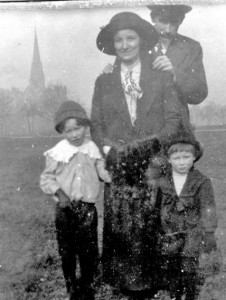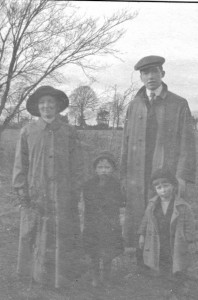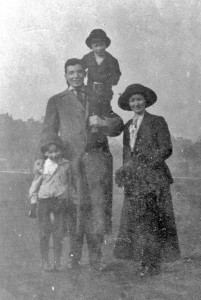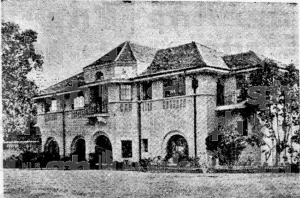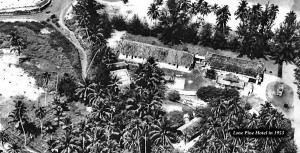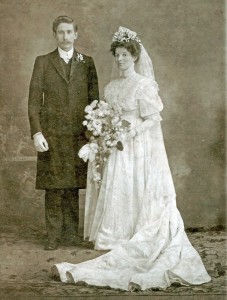 Albert Stanley McKern was born in 1885 in Sydney, Australia. He married Effie Florence Clark-Duff in 1908.
Albert Stanley McKern was born in 1885 in Sydney, Australia. He married Effie Florence Clark-Duff in 1908.
The Sydney Morning Herald Saturday 4 July 1908.
At St. James’ Presbyterian Church, Burwood, on June 3, Mr. Albert S. McKern, youngest son of the late Mr. Henry W. and Mrs. Hannah M. McKern, was married to Miss Effie Clark-Duff, only daughter of Mrs. Clark-Duff, of Burwood. The ceremony was performed by the Rev. R. Scott-West, assisted by the Rev. James McKee, of Penrith, and the Rev. Victor Clark-Duff, B.A., Cessnock, brother of the bride.
The church was tastefully decorated by friends. The bride was dressed in ivory white paillette silk, trimmed with Maltese lace, and she wore a lace veil over a coronet of orange blossom. Her shower bouquet and bracelet were gifts of the bridegroom.
Theological students and girlfriends of the bride formed a guard of honour from the carriage to the church. The bridesmaids the Misses Nellie and Kathleen Dill-Macky were dressed in cream silk voile, trimmed with gold silk cord, and wore white silk hats, trimmed with feathers. Their bouquets and brooches were gifts from the bridegroom. Mr. Victor Haigh, B.A., was best man. The Rev. J. H. Robertson, M.A., and Mr. W. T. Clark-Duff were groomsmen.
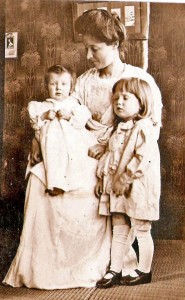 A reception was held at “Glen Elvyn,” Victoria-street, Burwood, after which the happy couple left for the south coast, where the honeymoon was spent.
A reception was held at “Glen Elvyn,” Victoria-street, Burwood, after which the happy couple left for the south coast, where the honeymoon was spent.
The McKerns had two sons: Eric Ronald [born 1909 died 1950 Annadale] & Ralph Noel [born 1911 died 1959 Scone] both born in Australia. A third son was born at Penang in 1924.
McKern attended the University of Sydney, where he studied theology; and in 1913 he left for New England where he enrolled at the Yale Divinity School and took up a position as a Presbyterian minister at the parish of Scotland in Windham County, Connecticut. His time there was noted as follows in A Modern History of Windham County, Connecticut …, Volume 1:
The Reverend Tenney resigned March 28, 1913, and was at once succeeded by Albert S. McKern of Sidney [sic], Australia, a student in the Yale Divinity School. He moved here in June, with Mrs. McKern and their two small sons and occupied the parsonage until October, when they returned to New Haven. He graduated the following June and after spending a few days here they sailed for England, expecting to return eventually to their native land. His pastorate though brief was an inspiration and the memory of his labors is like a benediction.
Some sources say he changed his subject of study while at Yale and took up Medicine there (still others say engineering (?)) because of what he thought was his lack of skill as a public speaker. Other sources say he only took up Medicine after he had finished his course in Divinity at Yale. Whatever the case, he graduated with a Medical degree from Edinburgh University in 1917. Below is the class photo showing the graduate doctors – McKern is third from the left seated.
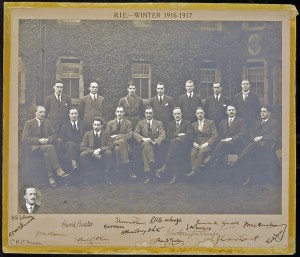
In 1917, after obtaining his medical degree, he moved to Penang, Malay(sia), where he practiced as a physician and surgeon. He set up a practice known as ‘Jamieson, Sharp & McKern’ at 39 Beach Street, Penang [1933 Directory] then later as Drs. McKern & Allan, at 4 Bishop Street, Penang. He resided at 552 Tanjong Bungah Road, Penang.
Dr. McKern was active outside his practice, serving on the Penang Hospitals Board and the Central Midwives Board. As a Justice of the Peace he was also a member of the Board of Visiting Justices under the Prisons Ordinance.
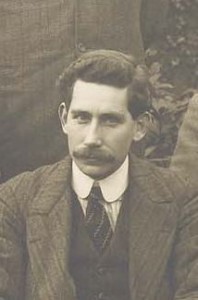
A prominent and popular physician, he was embroiled in a public controversy over conditions at the Penang Hospital in 1927 when all members of a visiting committee of which he was a member resigned in protest at the stand taken by the authorities.
McKern had a keen eye for property and according to his grandson Bill McKern: “ …. he built up both a successful medical practice and real estate holdings, mainly vacant beachfront lots of about three to five acres each. One was developed into his own house. He also bought a block of shop-houses in Georgetown, Penang’s heritage centre.”
In the 1930s, McKern built for himself and his family a residence in Tanjung Bungah Road, now the site of a four condominium tower block called “The Cove.” In an article under the headline, “House with a Supreme Site – Dr. A.S. McKern’s Residence in Penang,” The Straits Times of 19th September 1935, reported that the house had been designed by Messrs. McNeil and Miller, and the newspaper reproduced the following description from the journal Malayan Architect accompanied by a photograph of the house:
“Situated about four miles from town on the shore side of the north coast road, this new house enjoys what must be one of the finest sites in this part of the world for a residence. It overlooks the entrance to the harbour on the north with Kedah Peak in the distance and commands a fine view of the hills to the south.
“The plan has been arranged to take advantage of these views and the natural beauty of the site. Trees were preserved wherever possible and an effort has been made so to group the house and its appurtenances that the mass might conform with the general disposition of the landscape.
“The library and the owner’s suite above have been arranged at the west end of the site, as far as possible from the noisy elements of the house, namely the entrance and the kitchen wing. Privacy in these apartments has thereby been obtained.
“The sloping ground to the east caused the natural entrance to be from that end of the house. The floor of the porch and vestibule is some three feet below the ground floor of the house so that the dining room is not disturbed by the entrance, yet cross ventilation is obtained in that room.
“This arrangement also permitted of a mezzanine floor connecting the pantry and upper floor by service stairs so that this very necessary adjunct to a house in the tropics is thereby obtained in the most inconspicuous manner possible and no bedroom is disturbed by a back passage.
“The house is of fire resisting construction throughout. The exterior walls are finished in granolithic brushed out to expose the granite chips. The roof is covered with French tiles and all the valley gutters are copper.
“The interior walls and ceilings to all the rooms are plastered with hardwall plaster. The upper floor and stair are reinforced concrete finished with teak. The floors of the entrance, stair hall, lounge and loggias are paved with marble, whilst those of the library and dining room are finished with teak parquet.
“The walls and ceiling of the library are panelled with specially selected figured teak and built-in book cases and furniture are of the same material. There is a fireplace in this apartment executed in Bukit Mertajam granite having an electric fire in a burnished steel dog-legged grate.
“The dining room, which is of an interesting shape, has a domed ceiling with concealed lighting. The walls and ceiling of this room are stippled in a primrose yellow and the metal work is painted matt apple green tipped with gold.
“The owner’s bathroom and adjoining offices are carried out in Rosa Aurora del Portogallo Marble, the bath being sunk and a marble wall cupboard has a sliding plate glass mirror as a door. The other bathrooms and lavatories are tiled to 6 ft. 6 in. with mottled eggshell finished tiles, having mosaics on the floors.
“The walls and floors of the pantry and kitchen are also tiled. All the sanitary appliances are of the most up-to-date type, come coloured fittings having been installed. Hot and cold water is supplied throughout the house from a ‘cookanheat’ stove in the kitchen.
“The low arches on the ground floor provide wide shaded openings whilst on the upper floor uninterrupted views are obtained by the use of folding sliding steel casements and shutters. There are four specially designed stained glass windows in the house and ornamental grilles have been used in several places to ensure ventilation when the house is shut up.
“The internal finishings are all of selected teak and the ironmongery of bronze and chromium plate.”
The house was named Elysian and after the war it became a Royal Air Force leave centre.
His other properties included one that was leased after the war to the French plantation company Socfin that built its beach bungalow Villa Aremi there. Another of Dr. McKern’s properties was the Batu Ferringhi beach property Lone Pine. An early reference to the name is in a 1932 newspaper article reporting an accidental drowning. Anecdotal evidence indicates that Dr McKern built the original double-storeyd structure facing the lawn at Lone Pine as a maternity hospital and behind this building he intended to have a swimming pool as he believed that water exercises were beneficial to expectant mothers but this was never completed because of the war. www.lonepinehotel.com
However, McKern’s good fortune was cut short. With the arrival of World War II, Japan invaded Malay(sia) and on 8th December 1941, began bombing the island of Penang. In December 1941 or January 1942 McKern and his wife Effie left Penang for Singapore; their three sons having already left Penang before the outbreak of the war.
Once they had arrived in Singapore, Effie managed to find a place aboard a ship that evacuated her to London. McKern stayed on longer but managed to find a place aboard one of the last ships to leave Singapore – the Mata Hari. What happened to that ship and its passengers can be read on the ships page of this website HERE.
After his capture by the Japanese and during his internment at Palembang, Muntok, and Belalau McKern was actively engaged in caring for the prisoners. However he himself was also quite sickly. McKern’s is mentioned a few times in Gordon Reis’s diary as attending to his wounded hand:
18th March 1942 (Muntok). I hardly slept during the night but managed for a time to lie down on cement floor beside a man who had an overcoat. In the morning, after several appeals, I learnt there were some European Doctors in a Hospital. I was sent there eventually in a motor lorry and found myself in a building formerly used as a Chinese Coolie Line with Dr. McKern of Penang and several other Doctors there. Equipment consisted of what they and others had saved and brought in. They attended to my hand and cleaned it up very well indeed, but could not stitch it. Part of the whole building had been kept for the sick and injured of whom there were many ….
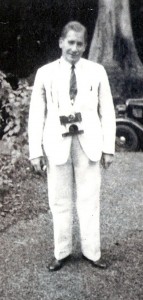
17th April 1942 (Circa) Palembang Jail . Took bandages off fingers under Dr. McKern’s advice who is in this camp and whereas they are not fully healed, they quickly covered over…
12th July 1944 (Muntok) fever (malaria) recurs. After talk with Dr. McKern (late Penang) now certain MALARIA and relapses set in. [Reis died four months later]
Three years after his capture and just two months before the end of the war, Dr. McKern died of amoebic dysentery in the Belalau internment camp in Sumatra on 16th June 1945. He was 60.
An expatriate planter, M. J. V. Miller, recorded in his diary: “Dr. McKern lost his suitcase in which he had all his clothes and a bottle of emetine [a drug used for amoebic dysentery from which he had occasional attacks].
“We had not been in Belalau long before he had another relapse, there was no drug to combat it…I was the second to last person to talk to him, and later helped to put him in his coffin which was just a rough box made of rough, unplained planks. We buried him among the rubber trees.”
William McDougall, who kept careful notes on camp life and death, mentions McKern in passing but does not record his death.
Just before he died, McKern asked for a pencil and a scrap of paper, the only writing materials that were available, because he wanted to write his will. He was very weak with malaria and dysentery, unable to sit up, but he could hold a pencil and his mind was clear.
In his will, the Doctor wrote that he wanted his wife and children to be cared for throughout their lives. He wanted his grandchildren to be educated and given a start in life. And then, ten years after these events had taken place, he wrote that he wanted all of his assets to be sold and the money given to medical research.
He stipulated that his doctor’s partnership be sold to reduce his overdraft. [These were probably loans that he was forced to take out as a prisoner in order to pay for basics such as food and medicine]. He instructed that bungalows and flats be built on his vacant land and that other properties in Penang be renovated and let out. His shares were not to be sold until they reached a certain price.
The income from these investments was to go mainly to his wife and three sons.
His wife Effie died in 1947 and two of his sons in 1950 and 1959. The 1997 death of his last surviving son triggered ten years later the legacy provisions of his will whereby the money raised from the selling of his property was to be divided three ways between his alma maters: Sydney, Yale, and Edinburgh universities.
The total amount raised was US $12 million to be put: “… for the sole and special purpose of establishing medical research scholarships for investigation into the causes, prevention and treatment of mental and physical pain and distress during pregnancy, labour and the puerperium”.
“As an obstetrician he would have participated in countless births and would have been saddened by the degree of suffering and death in those pre-antibiotic days” says Bill McKern.
Dr. Fiona Burns from Sydney’s Law faculty, an expert on inheritance law and succession, says it was a most unusual testament. “It appears that he was determined to provide his wife, children and family with income during their lifetime, but also ensure that the universities ultimately benefited from his asset holdings,” she says.
“In the light of what must have been terrible living conditions and ill-health, he demonstrated a remarkable clarity of thought and foresight.”
“He was a very generous person,” says another grandson, Bill’s brother Alan. “While I appreciate that we were able to enjoy the benefits of his will for so long, it was a very well-written document and he made it clear what he wanted. And I’m very happy with that. He would be amazed to learn how his assets have grown in value.”
“It’s an extraordinary story,” says Professor Bruce Robinson, Dean of Medicine at The University of Sydney. “Who could have expected that more than 60 years after Dr McKern’s death in a prisoner of war camp, his legacy would be used to improve the health of women during childbirth.”
Charles J. Lockwood, M.D., of Obstetrics, Gynecology and Reproductive Sciences at Yale notes that: “Prematurity is the leading cause of infant mortality in the United States, the leading cause of mental retardation, the leading cause of childhood blindness. It costs the U.S. economy around $28 billion a year in terms of health care-related resources. Preterm delivery is a national public health crisis.”
